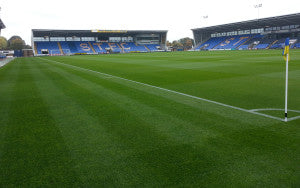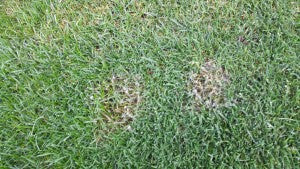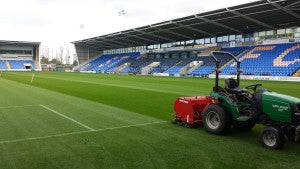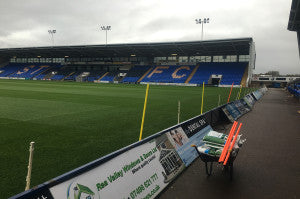Abi, Des and Harry too...

I finished my first article just before the club played Blackpool on Saturday 26th September, a game that Shrewsbury Town won to finally break their poor home form. The pitch continued to play well during the game and we spent an hour afterwards nursing any grass back up from tears and scars left by boot studs and blades.
On the Monday, we carried on with a morning of divot repairs, then brushed the pitch with the Dennis cassettes and followed with a rotary cut to clean up.
Tuesday 29th; we set out and applied 8 x 20kgs bags of Lebanon Country Club MD 12-0-24 +56% slow release nitrogen as a base feed to keep up the nutrients available in the profile for the plant.
On Thursday 1st October, we verti-drained with the Baroness spiker using a new set of tines to full depth on a tight pattern. It's an eight hour job, and sitting on an open tractor can get pretty demoralising and cold; the upshot is that you know what the benefits it brings to the health of the rootzone and the grass.
On Monday 5th October, we cut the pitch using the Dennis G860 and took off seven boxes of grass clippings, which was still encouraging for the time of year.
The next day, we applied 5 litres of Bullet Phosphite and 10 litres of Bullet Chelated Iron to the pitch.
We were now leaving the pitch alone when we didn't have reason to be on there and didn't resume work again until the Friday when we cut both ways and marked out ready for the next day's game.
 |
 |
| Pitch on 10th October | 'Verti-draining' on 15th October |
Saturday 10th; a later start as mostly prepared in advance. Monitored watering in the morning and through lunch, whilst we put the goals and safety nets up. The team played Colchester in the league and the pitch stood up well, as did the players, as they recorded a second home win on the bounce!
We carried out post-match repairs after the game and then again on the Monday morning, before 'hoovering' with the Honda rotaries. The next day we applied 10L of Bullet Calcium.
In this week, we also welcomed our new member to the team, Sam Ridgway, joining us from his previous groundsman's position at Ellesmere College. Sam had been helping us on match days for at least a season and is a staunch Shrewsbury fan, so it made sense to give my legs a little rest and get some new blood in to work alongside Richard and I.
On Thursday 15th, Sam got his first real taste of being the 'newbie' and spent the statutory eight hours on the verti-drain. Richard and I used the Hondas again to hoover the dross that fell off the verti-drain behind Sam.
We left the pitch alone then until Monday 19th, when we applied 15 litres of Maxwell chelated iron and 40kgs of Maxwell SolControl 13-0-39 +Mg, after first mowing with the cylinders and taking three boxes of clippings off.
We cut the pitch again on the morning of the 20th, marked out and got ready for the league match against Doncaster Rovers that evening. Playing a team that had lost seven games on the trot, we thought this would be another home win but, under the new management of Darren Ferguson, Doncaster had other ideas and spoilt the party.
Pitch repairs began after the game and continued the next day; then we left it alone.
On Friday 23rd, we verti-drained the pitch on a wider and quicker pattern and ran the Honda pros over it, before a final cut with the cylinders.
We played Bury the next day, having done final preparations and a mark out in the morning. Whilst I shouldn't mention it (because few actually noticed), the corner sprinkler came on with about ten minutes of the game left - the timer had been left on by accident! Doubly fortunate for us, the game was stopped for an injured player at the other end of the park and Richard had the remote in his pocket and turned it off within about six seconds! Still it did make us add "check the irrigation programme before games in future" to the list of match day duties.
After the scar repairs, we verti-drained the pitch again on the Monday and used the Hondas to clear up the debris and get the grass standing up.
On Tuesday 27th, we cut the pitch one way with the cylinders and got ready for an FA Youth Cup match. The weather was horrendous and it rained from about 3.00pm right through to final whistle. At times, it was torrential, coming down through the glow of the floodlights in curtains, but the pitch stood up well and, to be honest, probably played the best it had for two months.
We did minimal repairs on the Wednesday and again got the verti-drain out to open up even more holes through the pitch. It would be fair to say that the root length and mass was very good and we didn't have any worries at this stage about destabilising the surface. Keeping water moving through quickly and oxygen in the profile was our main objective, and the regular aeration/spiking seemed to be achieving this well for us.
Friday 30th; we took the verti-drain onto the training pitch and gave that a deep spike to help keep the surface drier, although being entirely clay based we didn't think that it would be in use for much longer.
 |
 |
| A little fusarium | 16th November and more aeration |
We fertilised the main pitch with eight bags of 3-3-12 Maxwell Premier fertiliser on Monday 2nd November. On the Tuesday, we started to notice a little fusarium on the poa dominated surrounds, and, after mowing the pitch on the Wednesday, could see that this was transferring across onto the pitch, so we sprayed with Chipco Green on the Thursday. Temperatures remained mild and the constant wet weather seemed to make it breeding heaven for disease pathogens.
On Saturday the 7th, the manager asked if they could train on the pitch, which we agreed to. They were due to play away against Gainsborough Trinity the next day in the FA Cup, and didn't have anywhere to train on the Saturday.
From 10th-13th, we experienced Hurricane Abigail, more and more rain. I remember when I used to go into work and feel that half inch or 10mm of rain seemed like a lot but, over the last few weeks, I'd be going into work and saying to Richard, "we had over an inch of rain again through yesterday and last night". It wasn't every day, but the west side of the UK was really copping the worst of these former hurricanes coming across the Atlantic.
On Saturday 14th, we were supposed to be playing Walsall at home, but they had managed to gain a postponement due to having three players called up for international duty. The assistant manager asked me if they could have a training session on the pitch instead, and they had the full squad out from 10am-12:30pm for training and 3 x 30min games.
 |
 |
| Honda 'hoovering' on 16th November | 17th November and a dose of Maxwell Premier |
On Monday 16th, the pitch was repaired and then verti-drained at tight centres, followed by the Hondas to cut and collect the debris.
The next day, we applied 8 x 20kgs of Maxwell Premier 3-3-12 on the pitch in the morning before the rain and winds of Hurricane Barney started! The next day, we came in to find the pitch side advertising hoardings were now spread and mangled across the pitch. There was a reasonable amount of damage to the grass in places and a few large gouges where the steel frames had dug in. We had to use angle grinders to separate much of the signage that was all bolted together the full length and width of the pitch.
On Thursday, the squad had another session on the pitch, citing that all their usual venues were now too wet to use, so we endured another two and half hours of warm ups/warm downs and short games.
Friday 20th, we repaired the damaged areas, verti-drained and used the Hondas for a clean-up. Over the previous few weeks, we'd been working hard on fabricating a lighting rig. I'd been down to Wolves to look at theirs and, armed with measurements and photographs, we set about building our own. We had some lengths of galvanised beams and sheets from the old irrigation tank roof, and I found a guy down in Sussex who was breaking some old Golf buggies, so I bought four axles and wheels from him. We bought some lengths of steel box section from a local supplier and, by kind courtesy of the West Midlands Police, we had some light fittings, bulbs and ballasts free of charge.
 |
 |
| Wiring the lighting rig ... | ... and testing that they worked! |
As I've said before, Richard is a dab hand at welding and fabrication, from his former life working at Stadco (an automotive supplier) so, with some felt pen drawings on the wipe board understood, he built the first rig with a large degree of professionalism and robustness.
The club electrician had been busy this week, creating a 3-phase supply for us from snack bars under the stands behind each goal, whilst we wired the rig and he then checked it and fitted the connections, before final testing.
We rolled it out for its first trial that evening. It was a proud moment for all of us, but more so for Richard and Andy Muir, as it was them who had first started the ball rolling at least twelve months earlier with West Midlands Police to get some seized grow lamps. In fact bizarrely, West Mercia Police, our local force, had refused to donate lights for legal reasons, so a massive thanks to West Midlands for their support.
The team again wanted to train on the pitch as suitably dry venues were seemingly at a premium, so Monday was spent watching them continue to create damage and us doing our best to repair it!
On Friday the 27th, we mowed the pitch in both directions with the cylinders and marked out ready for the League game against Gillingham, a game that ended in a 2-2 draw.
On Sunday 29th, Hurricane Clodagh descended; more rain, and the local area is starting to look more like marsh land as the River Severn burst its banks again. My rain gauge showed 58mm (nearly 3") of rain in a twenty-four hour period.
We cut and prepared the pitch through Monday and Tuesday, (the beginning of December already) ready for the rearranged Walsall game, which passed with a loss and not too much pitch damage. We repaired again on Wednesday morning, before a quick mow with the Hondas and a liquid application of SeaAction 10L Liquid Seaweed, Bullet Chelated Iron 10L and 50kgs of SolControl 13-0-39 +Mg.
At the beginning of this week, we took some soil samples from across the pitch and sent them off to be analysed.
On Thursday 3rd December we applied eight 20kgs bags of 3-3-12 Maxwell Premier granular feed.
Through Saturday and Sunday, Storm Desmond descended with high winds and yet more rain.
We received the soil analysis back from the lab on the 8th December; it made for pleasant reading. The macro and micro nutrients now fell within the required parameters, and phosphate was now at a very manageable level. Iron remained high at 1300ppm, so had dropped by over 500ppm since the first analysis in May. We hadn't even used a wetting agent on the pitch as yet so, all in all, a much more comfortable set of results.
 |
 |
| 18th December: south goalmouth | 18th December: Richard mowing with the Dennis G860 |
The pitch continued to cope with the excessive rainfall much better than could be said for the surrounds, which were now pudding-like. On Monday 14th, we cut the pitch, turning just off the lines to avoid the swamps off the pitch. To smell freshly cut grass in December was quite amazing and we removed six boxes of grass. The mild, wet weather caused us big problems with worms and their casts though. I'd say that we have lost more grass being buried under casts than by player damage, thus far.
To add to our recent woes of inclement weather and training, the team only managed a draw against non-league Grimsby in the 2nd round of the FA Cup, so we got the pitch ready for the replay on Tuesday 15th.
We repaired and mowed the pitch on the Wednesday and then continued our fortnightly trickle feeding with the application of eight bags of 3-3-12. The light rig was clearly starting to work and we had three yellowing bands of grass in the south end goal area where we kept moving the rig every forty hours.
 |
 |
| 18th December: soil profile | One of the lighting rigs with its 'shades' fitted |
We decided to try something a little stronger, feed wise, as the lights were clearly sapping up nutrients from the plants much quicker than the rest of the pitch, so we also put 30 kgs of potassium nitrate through the middle of the pitch. This probably wasn't our best idea ever, since the mild temperatures and rain led to another bout of fusarium and leaf spot, emanating from the middle of the pitch. We duly applied 1L of Medallion through the middle on the Friday.
We were also getting the pitch mown and ready for our League game against Swindon the next day. The pitch played well again; we were getting consistently good comments from all the away team coaches and players, which was well received by all of us. Obviously, the away teams liked to come and play on a decent surface and Swindon ran out 1-0 winners on the day.
Christmas Eve and Storm Eva hit, bringing another 38 mm (1.5") of rain with it overnight and into Christmas Day. We had prepared the pitch on the Thursday, with the exception of marking out, which we left until Boxing Day morning. The team managed a draw against Fleetwood, the pitch played much the same as before.
The team were then playing away at Crewe on the 28th, so trained again on the pitch on Sunday the 27th. I went in to speak to Mick Jackson, the assistant manager, that morning whilst he was setting up for the session and he agreed to spread the wear as best he could across the field.
The wet, but reasonably mild weather continued, with weather system after weather system coming from the west. On the night of Tuesday 29th through into Wednesday 30th, Storm Frank came knocking and we had another deluge of rain.
Friday 1st January; the team had a short training session on the pitch. To be fair, they had tried to find venues at Lilleshall, Shrewsbury College and Shrewsbury School, as well as the artificial five a side pitches that Power League have adjacent to the stadium. However, about half the squad won't train on the 3G surface because of joint ailments, so they need natural grass whenever possible.
We opened up the pitch again with the verti-drain on Monday 4th January and then applied Maxwell Premier Autumn & Winter 3-3-12 Regular x 8 bags, Lebanon Country Club 8-4-24 x 10 bags, 1 bag of Lebanon 12-0-24 through the middle from goal to goal the next day. Both the Lebanon fertilisers are slow release.
On the 6th January, we got the second light rig operational, and this now found a home in the north end goalmouth.
We left the pitch alone for the rest of the week, and turned down another training request so as to give the surface a much needed break.
The weather decided to turn more seasonably cold and, for the first time, we deployed the protection covers across the pitch as night-time temperatures dropped below freezing and we had a proper frost. Hopefully, this would also send the worms down deep and kill off disease pathogens on the surface.
On Saturday 16th, the team played and lost to Barnsley. Their league form, particularly at home, has been poor and we continually get ribbed about the pitch being too good. Some quarters believe we should make it bad like previous years to help level the conditions for both teams. However, the team seem to have had the guile and luck to progress in the FA Cup, having put out Championship side Cardiff the previous Sunday.
The cold weather didn't last and we returned to milder air and more rain the following week. All the covers were folded up and palletised back in the corner of the stadium.
We cut the pitch on the Monday and again left it alone until we verti-drained on Thursday 21st. On the Friday, we applied 8 x 20kgs of 3-3-12 Maxwell Premier feed.
The grass has certainly started to thin across the pitch; difficult not to expect this, but the goal areas are noticeably thicker and you can see the grass tillering like it's still full on growing season. We take off an extra quarter of a box of grass just going through the 18 yard box each time.
We had the rearranged Oldham League game on the 26th, giving the pitch a cylinder cut in two directions and marking out before the evening kick-off.
The repairs are taking longer now as we endeavour to close up as many of the scars as possible and rubber rake higher wear areas to get grass standing back up. We used the Hondas to clean the sward, rolled the pitch in both directions with the Dennis mowers and then sprayed with 10L of iron and 10L of seaweed on Thursday the 28th. As we near the start of February, you can't help thinking that spring and warmer weather could be just another four weeks away!
 |
 |
| Close up of north end on 29th January | 29th January: final preparation ... |
On the Friday, we again rolled the pitch with the G860s, putting some tractor weights in the grass boxes to provide a bit of additional weight. Storm Gertrude was now upon us and, although we seemed to miss the bulk of the rain this time (much falling on the Welsh Hills), we got a reasonable soaking through the night to help wet the profile for the game.
Saturday 30th January; big day for the club today as we host another Championship side, Sheffield Wednesday, in the FA Cup 4th round.
Pitch looks as good as it can for the time of year and we are faring better than most when you watch the football on TV. Our half year pitch marks came through this week as well, with a mark of 4.3, against a divisional average of 3.89, so pretty pleasing that we've turned the pitch around from a 2.9 at the same stage the previous season.
The coaches from Sheffield were very impressed with the surface, and it made for an exciting end to end game that resulted in Shrewsbury winning 3-2, with a late, injury time winner. The League form seemed a distant memory to the fans at final whistle, amid jubilant scenes. The upshot of the win, meant that the club was in the draw for the 5th round for the first time in sixteen years. At this stage, neither Richard nor I were bothered (we of course secretly wished for away draws in all the previous rounds) if we were at home, because we hoped that we'd be getting someone decent out of the hat.
The Sunday evening draw for the last 16, brought with it the plum draw that we all hoped for, and we'll be hosting Manchester United here towards the end of the month - by the time you read this, the game will have been played, but we can dream that the team pull off the impossible and the pitch does us proud as well.
We spent the Monday morning doing pitch repairs, and then used the Hondas in the afternoon to stand the grass up and collect grass debris. The weather again is horrible, with more rain coming in with Storm Henry and gale force winds making the stand roofs ripple and the grass dry out considerably.
When the club made it into the 4th round of the cup, it meant yet another postponement of our League fixtures; this time Southend. I had asked our club secretary if she could request a rearrangement for the end of March or in April, but the Football League were insistent that it should be played just three days after the Sheffield game. This flies somewhat in the face of what they told us at the Football League meetings back in October, where they want to help groundsmen. I emailed the League and, at the time of writing (ten days later), I am yet to receive the courtesy of a reply.
We mowed the pitch with the G860s one way - it had had enough presentation in the last eight days anyway with three games - and over-marked the lines ready for the evening's league game with Southend.

For televison purposes, the Manchester United game was played on the evening of Monday 22nd February, so we had twenty days to get the pitch ready. After we finished repairs following the game Tuesday night, we used the brush cassettes in the G860s to clean the surface and get the grass stood back up. This was followed by an overseed, using a Blec dimple seeder and five bags each of Limagrain's 75R and MM60. The hope being that temperatures would stay high enough for the MM60 to germinate as well as the 75R and we could get back to a 100% grass cover again, albeit aesthetically, before the cup game.
Following seeding, we verti-drained the pitch and then covered it with our frost sheets to help the new seed chit. We monitored the grass under the covers over the next few day to make sure there was no disease and, once the seed had germinated, took them off.
I will take this opportunity to thank the club's outgoing CEO, Matt Williams, who joined Burnley at the beginning of February. It was Matt who agreed our contract and he has been a great support throughout the last 9 months. Good luck for the future Matt!
I'll write part III at the end of the season, and hope then to provide a cost of this year's maintenance, in terms of products etc. used.
